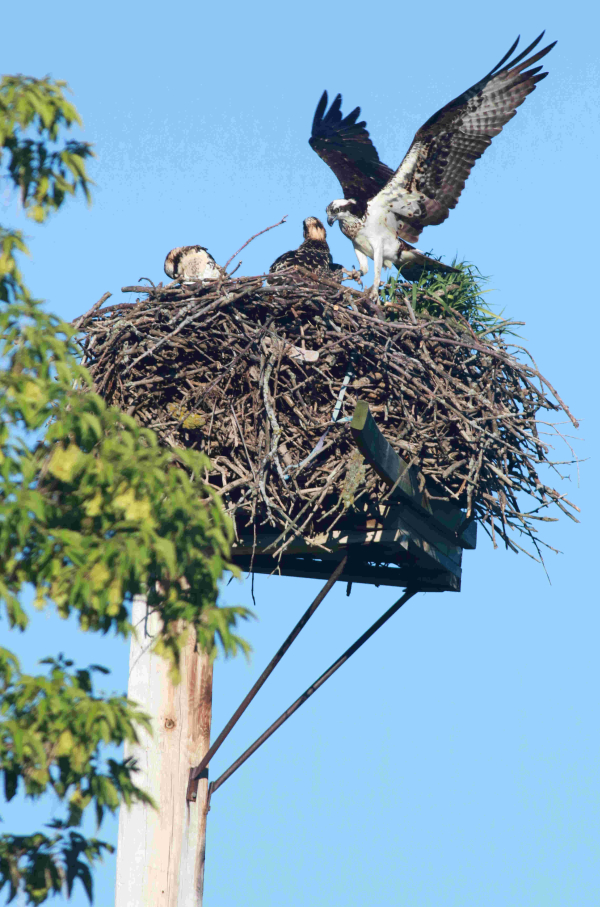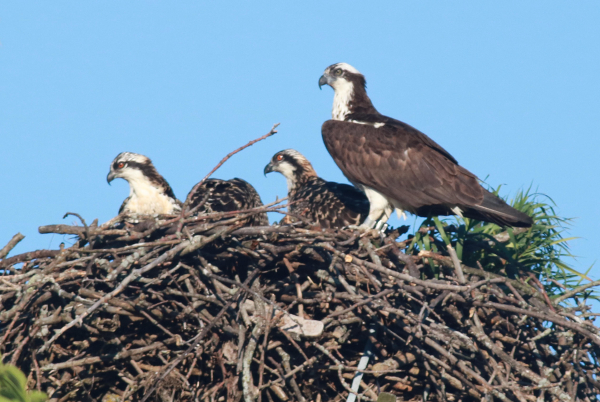
Ospreys have nested on this elevated platform for several years.

The size and weight of an Osprey or eagle nest dictates an ultra-sturdy pole, platform, and braces. The payoff is when a brood of Ospreys fledges from the platform, adding to the recovery success story of the species.
|
Across the United States and Canada, wildlife biologists and birding groups have aided in the re-establishment of large birds that were once endangered, including Ospreys and Bald Eagles, by constructing elevated nesting platforms that these majestic raptors have accepted by the thousands. Certainly you have seen some of these artificial nesting platforms before, but have you thought about introducing one into your community or a nearby nature center, refuge, park, or greenspace?
Ospreys and Bald Eagles prefer to nest near bodies of water with fish, and they can benefit local lakes by catching rough fish including carp. Other large birds also utilize these elevated nesting platforms, including hawks, Great Horned Owls, Great Blue Herons, and Golden Eagles – you never know what other birds might take a liking to your new nesting platform. Habitat will play a role in what birds will be interested, so give some thought to what birds you would like to attract to a given location and if that location provides premium habitat for them to hunt and feed and raise a brood season after season.
Phase 1: Planning
You don’t need to take on such a big project on your own; in fact, installing such a nest site is a great way to raise community awareness and public interest in the welfare of area birds. If birds adopt the site, it will be very inspiring for children, students, and your community at large. You may want to get your local Audubon chapter or birding club involved; or a nature center or national wildlife refuge. You may need to raise some money for materials, and even equipment rental, although if you contact the right people, they may lend essential help with materials and especially heavy equipment assistance.
Pole installation will be the biggest part of such a project, so don’t hesitate to contact the local utility company about helping out; they are experts at installing tall poles in the ground and are often open to helping with a worthy project that might give them some good public relations feedback and news coverage. Other options would be to find a helpful construction company or contractor that has the equipment and the interest to help install the pole and platform. Likewise, a big landscaping company with appropriate equipment might be interested in lending a hand. The state wildlife department might be supportive, and even a city or county commission, or a park board might lend the help of their equipment and operator for a few hours as a project partner.
Deciding where to position an elevated nesting platform is the obvious first step, and depending on where that might be, there may be some politics involved. You may need permission and even formal permitting to install a tall platform, so it’s a good idea to try to get the political entities to buy into the project as a part of a birding festival activity, a local conservation achievement goal, or just a worthy community project.
Phase 2: Construction
There are really three parts to the construction phase: Collecting materials including a long pole, building the platform, and preparing hefty supporting braces that will support the platform when attached to the pole. A wooden power pole, often referred to as a telephone pole, is perfect for the nest platform’s pole. Therefore the help of a power company would be especially helpful – for materials, equipment, and expertise.
If you have that kind of cooperation, the size of the pole is less of a concern, so opt for the tallest possible. If you can get the platform elevated 20 or 25 feet above ground, that would be great, but it may require a pole 30 feet long or longer, considering the need to anchor the pole fairly deep in the ground. The power company will have that kind of expertise to lend to your installation efforts.
Note: An alternate plan would be to use a trio of poles to hold the nesting platform securely in position.
The size of the platform will depend on the species you wish to attract. Ospreys and eagles will benefit from a platform about 4 feet by 4 feet in size, while Great Horned Owls, hawks, and herons will use a platform about 30 inches by 30 inches in size. But keep in mind, if you’re opting for a one size fits all nesting platform, the hawks, owls, and herons should accept a larger platform than needed, while an Osprey or eagle may not utilize a smaller platform.
Overall, the floor of the platform needs to be strong enough to support what may become a very sizeable and heavy stack of branches, especially as it is built up over successive years. The square-ish platform should be built with widely spaced pressure-treated boards that will provide drainage for rainwater and snow melt, and an elevated border is best to help keep nesting material on the platform. The braces that attach the platform to the pole and help to support it need to be equally strong, and some people prefer to use strong metal braces.
Phase 3: Installation
First, you will need to dig a deep, relatively thin hole not much wider than the pole itself. When the pole has been inserted into the hole, you may want to pour some quick-drying concrete into the hole to form a strong base, and to help protect the pole from rotting prematurely if the location has a potentially high water table. Again, information procured from the utility company will be most helpful.
Next, you may decide it’s best to get the pole in position first, then mount the platform and braces after the pole is secured; or you may decide to finalize platform and brace construction on the ground and insert the pole with the platform braced to the top as one unit. The equipment you have to work with may dictate which option you plan to use too.
Installing the pole, platform, and braces is a big job, so when the pole and platform is in position, break out the champagne and lead the group on hand in three cheers for a job well done. But there’s one more element to add: It’s a good idea to add some sticks to the platform to give birds that might check out the new nesting platform the idea of what this platform is meant for – it’s not a perch, it’s a nesting site – and the first collection of sticks for a bird nest offers the birds a welcome mat of sorts. You may even need to tie sticks and branches down so other birds don’t steal them for a different nest.
But if you’re trying to attract a Great Horned Owl, you must provide a “finished” nest for them, because the species does not build a nest – they commandeer the former nest of a hawk, raven, or another large nesting structure built by another species. So it doesn’t hurt to build up your nest a bit and add some finer material to the center for lining in case a regal owl claims it next winter.
As with any artificial nesting structure we birders add to the great outdoors, it may require some patience as big as the structure to give birds time to use it for nesting. It may require years of patience – or birds could claim it by next spring. Keep in mind that Bald Eagles often lay claim to a nest site during fall, so if eagles are your primary interest, don’t waste any time moving forward with a plan. Bald Eagles may hang out at and near the nest site during fall, and even add some twigs and branches then, but the pair will get serious during late winter to start next year’s nesting season.
For more information about building an elevated platform nest site, along with building plans, please consult NestWatch at the Cornell University Lab of Ornithology at https://nestwatch.org/learn/all-about-birdhouses/birds/osprey/ There is also quite a bit of information available on the internet about building an elevated nesting platform for Bald Eagles and Ospreys that you can also refer to – it’s always worthwhile to get as much information as possible when entering into such a considerable birding project.
Article and photographs by Paul Konrad
Share your birding experiences anytime at editors2tbw@gmail.com